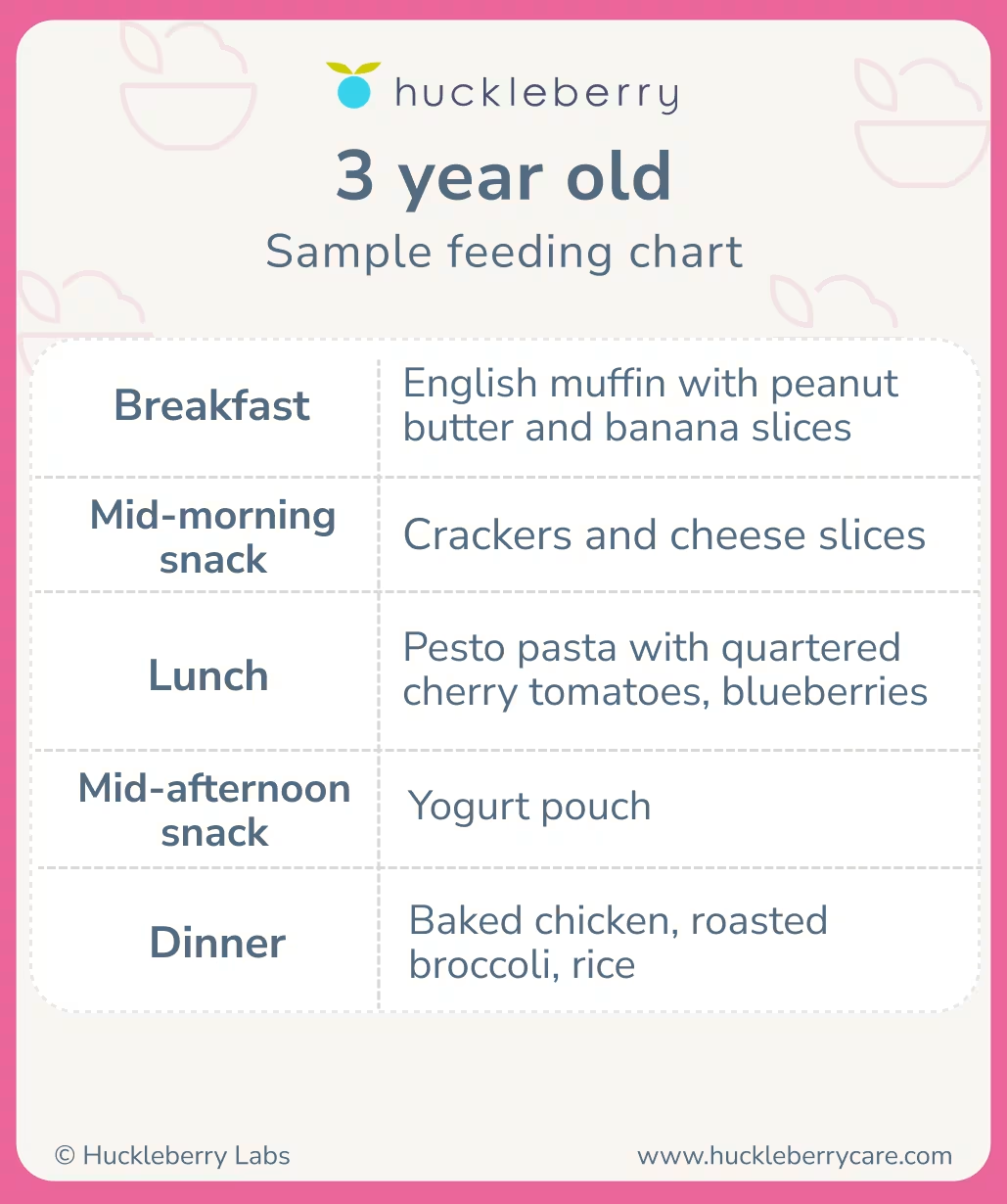3 year old feeding schedule: Amounts and food chart
Updated Oct 21, 2025

Feeding a three year old can be fun and, let’s be honest, frustrating! By now, your toddler has likely developed strong preferences for food. But, on a positive note, they are also capable of eating a variety of foods and participating in family mealtime. Keep reading to find out all there is to know about feeding your
3 year old toddler sample feeding schedule
When it comes to eating, three year olds are capable of so much! They are likely self-feeding, many times with utensils, and actively participating in family mealtime. Overall, they are eating the same foods as the family even if they show definite likes and dislikes. Parents should still be aware of high-risk choking foods at this age.
Typically, preschool-aged children will eat every 2.5 - 3 hours adding up to about five times a day. Most often, this is spread out as three meals and two snacks a day.
Below is a sample feeding schedule for a 3 year old which may be modified to meet your family’s needs.
| Time of day | Meal |
|---|---|
| 7:00 AM | Breakfast |
| 9:30 AM | Morning snack |
| 12:00 PM | Lunch |
| 3:00 PM | Afternoon snack |
| 6:00 PM | Dinner |
How much to feed a 3 year old: Food chart
behaviors are still common, and largely normal, at three years old. Keep offering a variety of foods and don’t pressure your child to eat certain foods. Model positive eating habits such as eating without distractions, consuming a variety of foods, and limiting talk about good vs bad foods. When the going gets tough, trust your kiddo will come around in their own time. Here are some to help you out.
3 year old feeding chart
| Time of day | Meal ideas |
|---|---|
| Breakfast: | English muffin with peanut butter and banana slices |
| Mid-morning snack: | Crackers and cheese slices |
| Lunch: | Pesto pasta with quartered cherry tomatoes, blueberries |
| Mid-afternoon snack: | Yogurt pouch |
| Dinner: | Baked chicken, roasted broccoli, rice |

5 tips for feeding your 3 year old
Tip | Notes |
Involve your toddler in food prep | Let your toddler help choose and prepare foods, from picking produce at the store to mixing or tearing ingredients at home. It builds confidence and interest in trying new foods. |
Expect strong food preferences | Kids this age often have big opinions about food. Avoid power struggles by offering familiar and less-liked foods together and reminding them they don’t have to eat everything. |
Reduce mealtime distractions | Give a 5-minute warning before meals and use a visual timer to help your busy toddler transition from play to the table more smoothly. |
Offer choices when possible | Give simple, structured choices like “blueberries or strawberries?” to give your child a sense of control and encourage cooperation at mealtimes. |
Focus on what you can control | As your child’s world expands, focus on the foods you serve at home rather than those they encounter elsewhere — that’s where your influence matters most. |
Tip #1: Involve your toddler in food prep
Toddlers are natural helpers so take advantage! Let them help with food prep and planning as much as possible.
Take them to the grocery store and explain how you choose foods for the family. In the kitchen, let them mix foods together, pour ingredients with help, or tear lettuce leaves.
Tip #2: Expect strong food preferences
Dealing with your three year old’s strong opinions can be tough at mealtime, but they are a part of typical development. Kids at this age often have strong likes and dislikes when it comes to food - and they make sure you know it!
Avoid power struggles by letting them know they don’t have to eat anything they don’t want to and by serving less liked foods alongside foods they typically accept.
Tip #3: Reduce mealtime distractions
You don’t need us to tell you this, but three year olds are busy, busy! It can be hard for them to stop playing and exploring in order to eat. Transitioning to a new activity, especially when it’s not on their terms, can be difficult for some kids.
Giving a five-minute warning before meal or snack time and using a can help manage your child’s expectations and get them prepped to come to the when it’s time.
Tip #4: Offer choices when possible
While parents and caregivers should be the ones deciding what’s served, it’s okay to offer your little one simple choices. An example would be asking, “Would you like blueberries or with your breakfast?”
Involving your toddler in decision-making helps give them a sense of control and can make it more likely for them to eat what you offer.
Tip #5: Focus on what you can control
Choosing the foods you serve your family is highly personal and can become complicated as children get older. They may begin preschool or spend time at friends’ houses.
While it can be difficult to watch your child be exposed to foods you may not otherwise choose, it’s best to take a deep breath and focus on what you can control - what you bring into your own home.
Night feedings at 3 years old
At three years old, kids shouldn't eat overnight. Ensure your child isn't hungry overnight but encouraging them to eat throughout the day. Consider adding a simple bedtime snack if needed. If your child is frequently waking overnight due to hunger, chat with your pediatrician to rule out any underlying issues.
Takeaway
Focus on what you can control: While you can’t decide what they might like or dislike on any given day, you can do your best to offer a variety of nutritious foods and to model positive eating habits.
Involve kids in the kitchen: Overall, have fun and introduce new skills and interest in foods by allowing them to help with age-appropriate tasks.
Picky eating is still common: While frustrating, it's normal for your 3 year old to refuse new foods. Avoid power struggles by letting them know they don’t have to eat anything they don’t want to and aim to serve new foods alongside foods they typically accept.
If you’re curious about what lies ahead when it comes to feeding, check out a . Take a look back at how far you’ve come by revisiting a .
3 year old feeding schedule FAQ
Share article:
Note: The content on this site is for informational purposes only and should not replace medical advice from your doctor, pediatrician, or medical professional. If you have questions or concerns, you should contact a medical professional.








